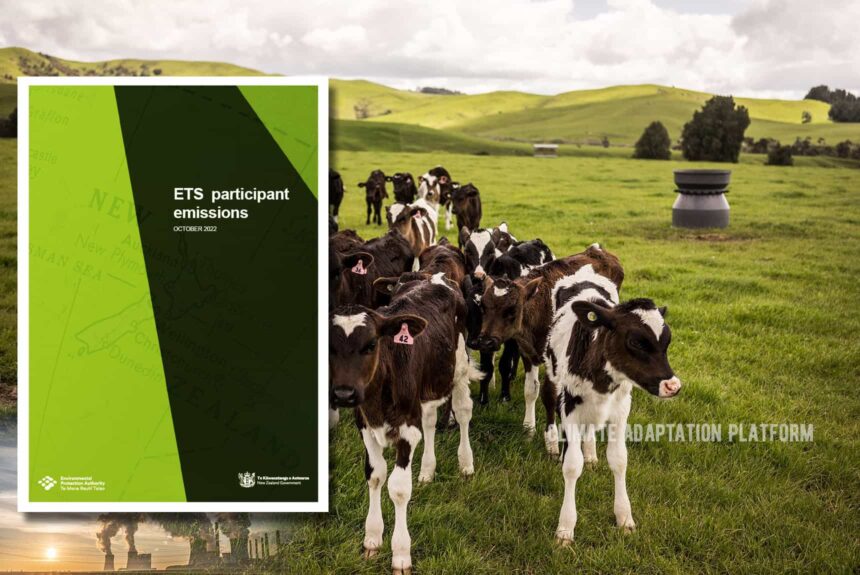New Zealand’s Environmental Protection Agency released a report on October 2022, “ETS participant emissions”, showing participants’ emissions in New Zealand’s Emissions Trading Scheme (ETS) from 1 July 2021 to June 2022 (ETS participant, 2022).
There are 2,887 participants in the ETS, both from the mandatory participants (281) and opt-in participants (2570) – a vast majority were involved in post-1989 forestry.
The report shows that the mandatory participants reported a total of 67,810,950 tonnes of CO2e emissions. Opt-in participants in the liquid fossil fuels and stationary energy sectors reported a further total of 2,981,811 tCO2e emissions, bringing the total reported emissions to 70,792,761 tonnes.
What stands out in the report is that New Zealand’s agriculture has the highest per tonne CO2 emissions among all sectors, at 48%.
Liquid fossil fuels (petrol, automotive and marine diesel, aviation spirit, jet fuel, light fuel oil, and heavy fuel oil) is a far second at 24%, and stationery energy (activities of importing coal and natural gas, mining coal and mining natural gas, geothermal fluid, combusting used oil, waste oil, used tyres or waste, and using crude oil or other liquid hydrocarbons) is at 23%.
Meanwhile, emissions for industrial processes (production of iron, steel, aluminium, clinker, burnt lime, gold, and glass) is at 3%, and waste is at 1%.
You can see the breakdown of the ETS participants here.
When it comes to individual businesses and companies in New Zealand, the report names Fonterra, New Zealand’s largest dairy company and exporter of dairy products, as the 2022 top emitter and also, for the second year running, with emissions of 13.1 million tonnes followed by oil companies at 2nd, 3rd, and 4th place. The fifth is the country’s meat processing firm, Silver Fern Farm, the country’s red meat processor and exporter.
Stuff reveals New Zealand’s top polluters based on the EPA 2022 report:
- Fonterra (13.1 million tonnes)
- Z Energy (6.8 million tonnes)
- BP (4.9 million tonnes)
- Mobil (4.7 million tonnes)
- Silver Fern Farms (3.8 million tonnes)
- Todd Group (3.0 million tonnes)
- Affco (2.7 million tonnes)
- Alliance Group (2.6 million tonnes)
- OMV group (2.6 million tonnes)
- Genesis Energy (2.5 million tonnes)
Comparing New Zealand’s emissions with other OECD countries, The Ministry for the Environment reveals that New Zealand’s emissions profile is unique among other OECD countries because almost half of its emissions come from the agriculture sector, above transportation, energy, and industries which makes it unique among other OECD countries.
Typically, agriculture accounts for only a tiny percentage of gross emissions.
The country’s high agricultural production means it emits a lot of methane and nitrous oxide – GHG that is more powerful than carbon dioxide in warming the planet, making the sector the country’s most significant contributor to climate change.
On 11 October, New Zealand’s former Prime Minister Jacinda Ardern, together with her Agriculture Minister Damien O’Connor and Climate Change Minister James Shaw, introduced a scheme that will require farmers to pay for their GHG emissions, which includes methane from cow burps and nitrous oxide emissions from the use of synthetic fertilisers and form livestock urine, by 2025.
See our blog post on this: NZ Govt Proposes Agriculture Levy as a Climate Change Measure
New Zealand’s former PM Jacinda says that the tax on agriculture emissions, planned to be implemented in 2025, is good for the New Zealand economy.
“The proposal, as it stands, means New Zealand’s farmers are set to be the first in the world to reduce agricultural emissions,” said Ardern adding that it would give the country’s biggest export market (worth $46.4bn a year) a competitive advantage globally while putting the country on track to meet its 2030 methane reduction target” (Corlett, 2022).
New Zealand’s former PM’s words have proven to be correct.
A few months after declaring her government’s proposed agriculture levy, Tesco, a British multinational grocery, announced wants all its suppliers of fresh meat, dairy, and produce to meet net-zero requirements, including those from New Zealand. The business wanted to reach net zero across its supply chain by 2050. The international supermarket chain is New Zealand’s largest buyer of its meat products, buying 36,340 tonnes of sheep meat valued at $521 million.
Check out our blog post on this: Will Tesco’s Sustainability Conditions Influence Emission Reduction in NZ?
As the number of countries, businesses, and other institutions pledging to get to net zero by 2050 grow, sustainability and low-emissions requirements for producing energy and goods will only get stricter and continue in the future.
New Zealand embracing and implementing measures to reduce its agricultural emissions will set the sector, particularly its farmers, to benefit from being first movers. Ardern notes that “cutting emissions will help New Zealand farmers to not only be the best in the world but the best for the world” (Corlett, 2022).
Sources:
ETS participant emissions. (October 2022). Environmental Protection Authority. Retrieved from https://www.epa.govt.nz/assets/Uploads/Documents/Emissions-Trading-Scheme/Reports/Emissions-returns/Participant-Emissions-Report.pdf
Gibson, E. (2023, January 19). New Zealand’s biggest climate polluters, ranked. Stuff. Retrieved from https://www.stuff.co.nz/environment/climate-news/130991637/new-zealands-biggest-climate-polluters-ranked
Corlett, E. (2022, October 11). New Zealand farmers may pay for greenhouse gas emissions under world-first plans. The Guardian. Retrieved from https://www.theguardian.com/world/2022/oct/11/new-zealand-farmers-may-pay-for-greenhouse-gas-emissions-under-world-first-plans
How New Zealand compares to other countries. (2021 April 15). Ministry for the Environment. Retrieved from https://environment.govt.nz/publications/new-zealands-greenhouse-gas-inventory-1990-2019-snapshot/how-new-zealand-compares-to-other-countries/
Uys, G. (2022, December 19). Tesco’s warning to New Zealand farmers. Stuff. Retrieved from https://www.stuff.co.nz/business/farming/130784599/tescos-warning-to-new-zealand-farmers



Leave a Reply